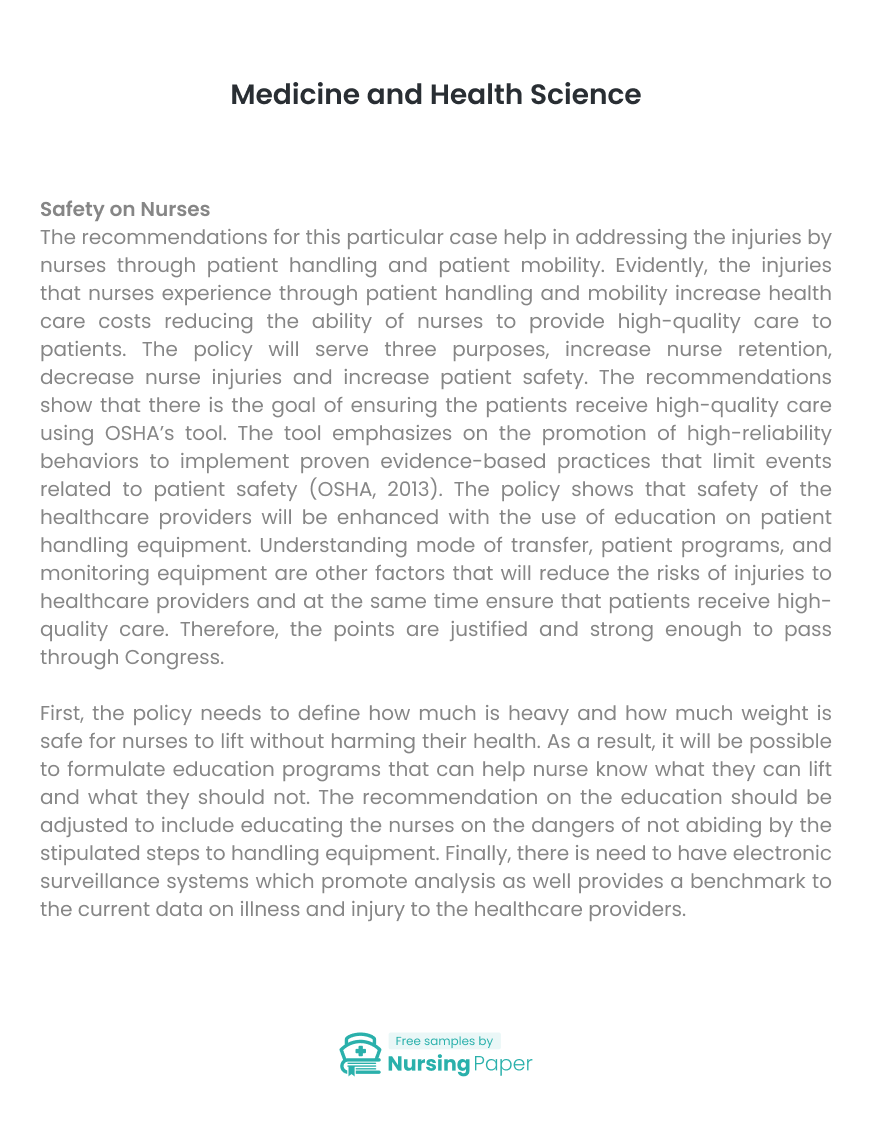
Medicine and Health Science
Safety on Nurses
The recommendations for this particular case help in addressing the injuries by nurses through patient handling and patient mobility. Evidently, the injuries that nurses experience through patient handling and mobility increase health care costs reducing the ability of nurses to provide high-quality care to patients. The policy will serve three purposes, increase nurse retention, decrease nurse injuries and increase patient safety. The recommendations show that there is the goal of ensuring the patients receive high-quality care using OSHA’s tool. The tool emphasizes on the promotion of high-reliability behaviors to implement proven evidence-based practices that limit events related to patient safety (OSHA, 2013). The policy shows that safety of the healthcare providers will be enhanced with the use of education on patient handling equipment. Understanding mode of transfer, patient programs, and monitoring equipment are other factors that will reduce the risks of injuries to healthcare providers and at the same time ensure that patients receive high-quality care. Therefore, the points are justified and strong enough to pass through Congress.
First, the policy needs to define how much is heavy and how much weight is safe for nurses to lift without harming their health. As a result, it will be possible to formulate education programs that can help nurse know what they can lift and what they should not. The recommendation on the education should be adjusted to include educating the nurses on the dangers of not abiding by the stipulated steps to handling equipment. Finally, there is need to have electronic surveillance systems which promote analysis as well provides a benchmark to the current data on illness and injury to the healthcare providers.


Workplace Violence
Physical assaults form patients can be very demoralizing. It can have both negative physical and psychological well-being on a healthcare provider. As such, it can affect the motivation of nurses, put the provision of healthcare at risks and can even lead to financial losses to the health sector. Since I am not immune to physical assault, I am likely to be harmed physically and emotionally as a result of a physical assault from a patient. However, I will try to be positive bearing in mind that the patients may be suffering from varied conditions that prompt their behaviors. These conditions include drug abuse, hurt patient, or patients dealing with trauma among others. Most importantly, I will report the incidence to emergency nurses, seek medical attention in case the physical injury and report the case to administration.
Intervention programs that would help reduce physical assault among healthcare workers will be focused on awareness, education, and devising of prevention criteria. The intervention measures include the use of awareness program that prohibits workplace violence. Posters that advocate for non-tolerance against workplace violence need to be implemented. One approach is to ensure that potentially violent patients do not have access to objects that can be used to harm a nurse (Roca, Charen and Boronow, 2016). Procedures that encourage and facilitate reporting should be used. Also, monitoring and reporting of physical assault incidences need to be done regularly as they help in devising best approaches to dealing with such cases. There is also need to have nurses aware of their rights and that ANA should work with a term of violence against nurses so that measure can be taken to address the charges pressed after an assault.
1. OSHA. (2013). Integrating Patient and Workplace Safety Programs. OSHA. Retrieved from https://www.osha.gov/Publications/OSHA3730.pdf
2. Roca, R. P., Charen, B., & Boronow, J. (2016). Ensuring staff safety when treating potentially violent patients. Jama, 316(24), 2669-2670.



The download will start shortly.

The download will start shortly.
 Subject:
Nursing
Subject:
Nursing  Number of pages: 10
Number of pages: 10  Subject:
Nursing
Subject:
Nursing  Number of pages: 3
Number of pages: 3  Subject:
Nursing
Subject:
Nursing  Number of pages: 1520
Number of pages: 1520  Subject:
Medicine
Subject:
Medicine  Number of pages: 2
Number of pages: 2  Subject:
Nursing
Subject:
Nursing  Number of pages: 5
Number of pages: 5  Subject:
Nursing
Subject:
Nursing  Number of pages: 2
Number of pages: 2  Subject:
Nursing
Subject:
Nursing  Number of pages: 5
Number of pages: 5  Subject:
Nursing
Subject:
Nursing  Number of pages: 4
Number of pages: 4  Subject:
Nursing
Subject:
Nursing  Number of pages: 13
Number of pages: 13  Subject:
Nursing
Subject:
Nursing  Number of pages: 8
Number of pages: 8  Subject:
Medicine
Subject:
Medicine  Number of pages: 3
Number of pages: 3  Subject:
Health and Social Care
Subject:
Health and Social Care  Number of pages: 5
Number of pages: 5  Subject:
Health and Social Care
Subject:
Health and Social Care  Number of pages: 4
Number of pages: 4  Subject:
Nursing
Subject:
Nursing  Number of pages: 4
Number of pages: 4  Subject:
Medicine
Subject:
Medicine  Number of pages: 14
Number of pages: 14 
